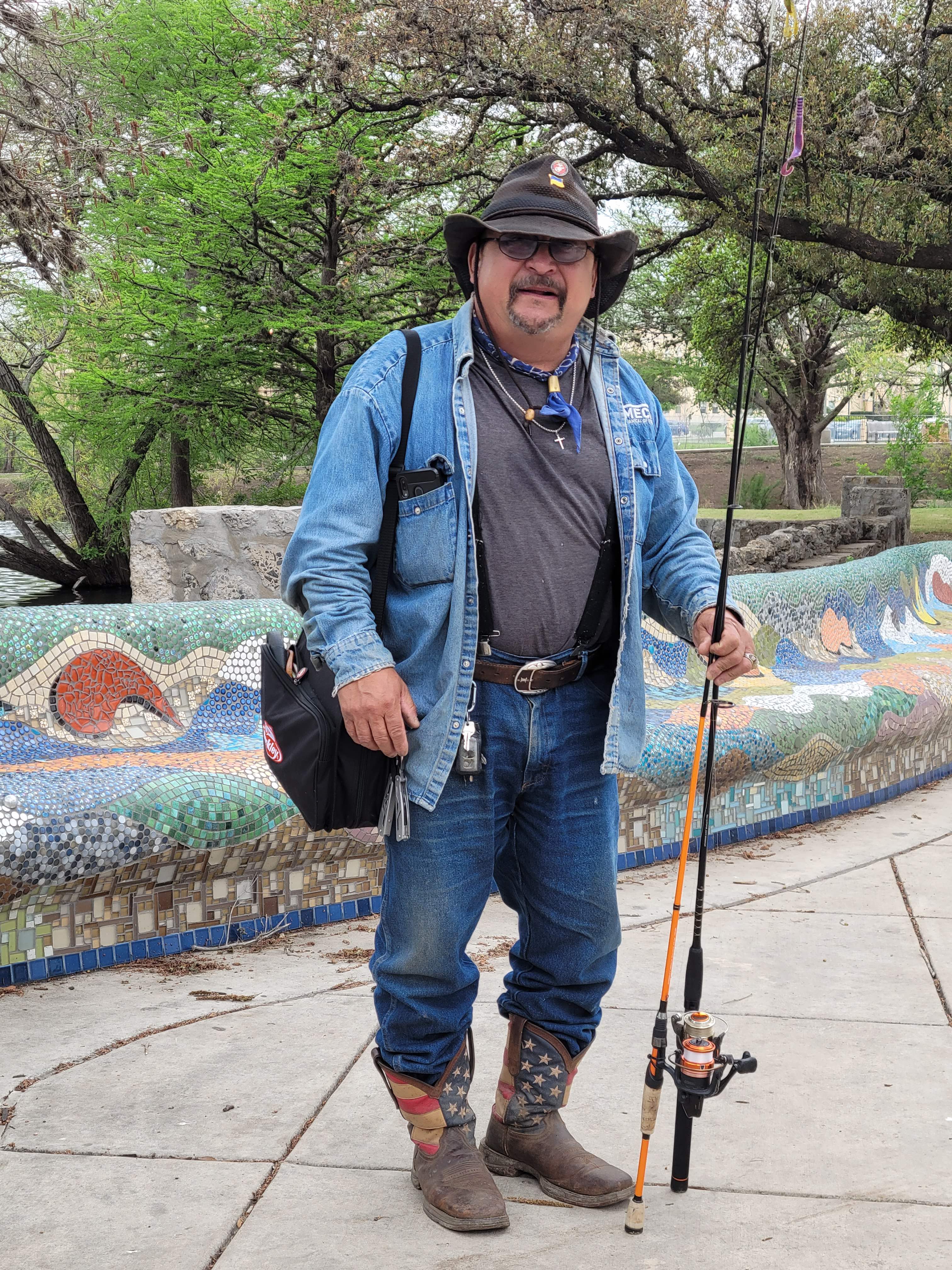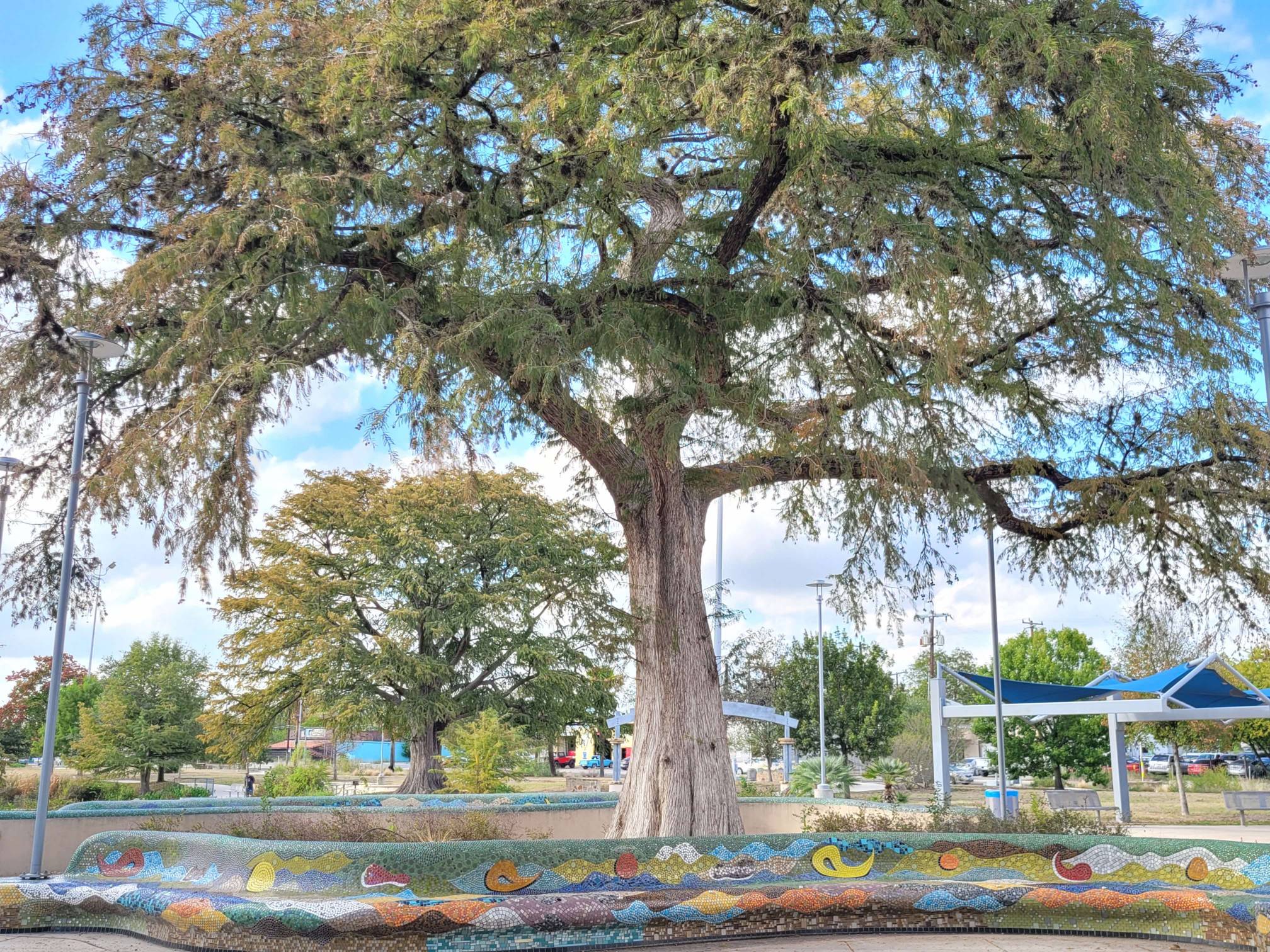Partner Spotlight: Rachel Cywinski
Partner Spotlight: Rachel Cywinski
In this issue, we shine a well-deserved spotlight on Rachel Cywinski, a Texas Stream Team community scientist with the San Antonio River Authority's (SARA) River Warriors program and an Alamo Area Master Naturalist. She monitors two sites in San Antonio, Elemendorf Lake on Apache Creek in West San Antonio and the Greenline Park at the former Brooks Air Force Base.
Rachel is certified in almost all trainings offered by Texas Stream Team, which highlights her unwavering commitment to safeguarding our natural resources. In a world where every drop counts, her dedication is a source of inspiration, reminding us that together, we can shape a brighter, cleaner future for Texas waterways and beyond.
What motivated you to get involved with Texas Stream Team?
I was trained as a docent in the first formal docent class of San Antonio Missions National Historical Park in 1997. When I purchased a house uphill from the Missions Trail, I thought that if I ever retired, most likely, I would spend much of my time volunteering there. I volunteered at San Antonio Missions National Historical Park for many years, but it was always a challenge to balance being on-site for a half-day each week while working and attending classes. I wanted a volunteer opportunity where I could make a major contribution to the San Antonio community on my schedule. I was willing to complete extensive training if needed and began pestering Minna Paul, who coordinates volunteers at SARA, to find an opportunity for me. She initiated some new volunteer programs, but after training, we realized the staff interpreted flexible scheduling to mean we would flex to their schedule. I insisted there must be SOMETHING the River Authority needed volunteers to do that would allow me to earn a living without a schedule conflict.
I became a water quality community scientist because Minna Paul listened to my insistent demands and then, instead of asking staff how volunteers could assist them with their work, asked what things SARA was unable to do itself and needed volunteers to get accomplished. Many portions of local waterways were not being monitored for water quality, and Minna connected SARA with the Texas Stream Team to get volunteers trained.
The first training we attended was the first one Rachel Sanborn taught over Zoom during the onset of the COVID-19 pandemic. Rachel expressed her frustration at not being able to instruct us in laboratory procedures in-person. Yet, her determination to continue training volunteers was stronger than her frustration, and she created a way to instruct us.
What sites do you monitor water quality?
When we looked at the San Antonio region's active and inactive monitoring sites, I was shocked by how few there were. So many waterways contribute to the San Antonio River, and most had no regular monitoring. Other volunteers and I were even more stunned that Elmendorf Lake on Apache Creek in historic urban West San Antonio was not a monitoring site because the removal of native birds to improve water quality there was an ongoing controversy at the time. So, I applied for a site ID and began my monthly monitoring at Elmendorf Lake, over time learning to be very specific in my comments about circumstances that impact water quality, such as people sleeping under the picnic tables at night and using the area as a toilet.
The other site I monitor is the Greenline, which is in a new urban redevelopment of the former Brooks Air Force Base. Doing the research needed to apply for a site ID answered so many questions and helped me understand the puzzling observations I had made over the years. The current Greenline largely follows the waterway path that the Spanish Franciscans in the 18th Century connected to the San Juan Acequia to water their farmlands at Misión San Juan de Capistrano. Now that it is partially restored and supplemented with recycled water, the Greenline again flows into the San Juan Acequia, which then returns flow to the San Antonio River.

What has been your favorite part about participating in Texas Stream Team? How has volunteering with Texas Stream Team made an impact on your life?
I hope to provide confidence to people concerned about their neighborhoods, so they have more agency to create a safer community where they live. Some of the most difficult days are when I realize the water quality testing results are not within the parameters to sustain life over time. I realize that if the aquatic life is alive at all, it is struggling while just a short distance from me are people throwing their fishing lines in the water and talking about how the fish aren't biting.
For many people drawn to these quasi-natural waterways for entertainment, this is as close as they have ever been to a natural area. They do not understand how we have degraded the environment because they have not seen a natural area. Others realize and feel helpless. One day a man stood by the Greenline weeping. He had grown up regularly walking the intermittent Creek in Brooks Air Force Base and said seeing trash in the water had broken his heart.
What is it about Texas Stream Team’s mission that is inspiring to you?
I am grateful to the San Antonio River Authority for finding a way that I could contribute to the community on my schedule. I like to think that I would regularly take a meal to the creekside and enjoy it sometime other than when I walk my dogs. But committing to showing up two places every month has caused me to realize how erratically I actually went to enjoy our waterways before. When I visit the monitoring sites, I return with the supplies and equipment from the Texas Stream Team kit, wash myself, unpack my meal, and take time to sip and savor what is there.
Specific to the mission (inspiring research, innovation, and leadership that ensures clean, abundant water for the environment and all humanity), I am inspired most for us all to catch this vision where we each live.

Have you made any surprising findings while monitoring water quality that you’d like to share?
My research indicates the Air Force likely stopped the historic flow into the waterway from upstream with a huge embankment on the north side of the base. This may explain the several decades of severe flooding in the neighborhoods where Air Force base employees lived, which led to a recent City of San Antonio multi-million-dollar flood control project.
It surprised me that, as different as these two sites are in many ways, there are many similarities in my observations at both sites. Both are urban sites with new paved trails designed to encourage recreation. Both permit catch-and-release fishing but prohibit human contact with the water and non-fish wildlife. Both waterways are heavily supplemented by recycled water. And, both waterways are heavily impacted by poor riparian management practices in the surrounding parks and persistent trash in the water. A very striking observation is that the Low Impact Design features in both parks cause the waterways to be more polluted when the land in the park is mismanaged. We have a huge problem with garbage in the urban waterways of San Antonio.
Some of what I see is discouraging, but that is what makes my persistent presence more effective. These are not problems that one person can solve. As I continue showing up, even once a month, more people who have seen me while walking their dogs or fishing ask me questions. These are people who are deeply concerned about incidents they have witnessed and want to know what the law says and how to report upsetting incidents. Most of the concerns at the Greenline are about people abusing wildlife. At Elmendorf Lake, residents have observed people drowning litters of newborn puppies or kittens--much like the bygone days of rural living but not lawful in the City of San Antonio. I explain that yes, this is unlawful, who to call to report this, and how to direct people to the free or discounted spay-neuter services if they can share that information.
What advice would you give to those considering becoming a community scientist with Texas Stream Team?
I encourage everyone to become a Texas Stream Team community scientist! There is so much need. Most of the waterways in Texas are unmonitored or infrequently monitored for water quality. Plus, due to the tremendous influence of the Meadows Center, many volunteers are students. Some go on to careers where they utilize water quality monitoring skills they honed as volunteers, but there is a constant need for more volunteers.
I was privileged to be trained in a class where a family was participating, and I learned from them that community scientist opportunities are great family activities. Each family member has a monitoring site, and all the others are there to support each other at each site. With a picnic breakfast, lunch, or dinner, the family can spend a day together every month, enjoy the waterways and each others' supportive presence, and significantly contribute to the health of Texas waterways by providing longitudinal data on multiple sites over many years.
And so, my one wish is to let people know that each can make major contributions by volunteering as a community scientist at any stage of life...and that they are needed!
